BR vs UHD, Capt. Kessler is surprised
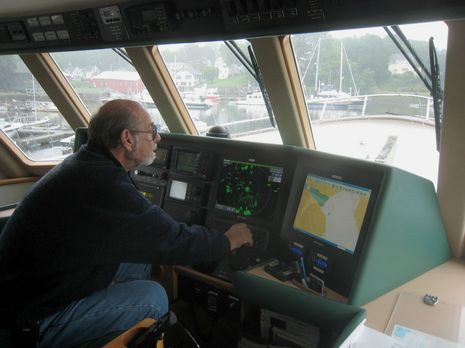
The weather here — a phenomenal run of rain and fog — has been great for testing the Broadband Radar temporarily installed on Li’l Gizmo, and I promise a screenshot show soon. But I’ve realized that while I’ve used many radars, and seen many others demonstrated, I’ve never had one on my own boat, and thus am not dead sure that the performance I’m seeing is as amazing as it seems. How convenient, then, that the indomitable Spirit of Zapolite cruised in out of the murk on Monday, complete with a brand new Furuno NavNet 3D system swinging a 4′ Ultra High Definition array. That’s the indomitable Capt. Kessler above, trying to tune NN3D/UHD to get as crisp and detailed an image of Camden Inner Harbor as he’d just seen on a 14-foot outboard!
Bruce was truly impressed with BR’s ability to target the crowd of boats moored and moving around the inner and outer harbors, not to mention the invisible nav aids at the entrance, even with all BR controls set to ‘auto’. And he thought it was doing at least as good a job at close ranges as his new UHD array, perhaps even better. But we both have some homework to do. He’s just learning his system (and I’ve seen a well-tuned UHD on a smaller boat capture close targets beautifully). Meanwhile, I’m about to try the BR24 mounted more realistically on big Gizmo’s mast, and compare it with a new Raymarine RD418D, aka a 4kW 18″ “Digital” dome. (Good times ahead, once I finish the damp multi-installation mess I’ve created.)
There’s no question, though, that Broadband Radar and the Lowrance HDS10 as installed above do a great job at the 1/4 mile range seen on the screen, and less, which is super for getting into and around a complicated place like my harbor. And, yes, that’s an AIS target on the HDS screen, and that black Y-Tronic combo antenna is connected to a Digital Yacht AIT250 Class B, which is holding up fine sitting in Li’l Gizmo’s battery box. So is Jeppesen Nobeltec, running at Spirit of Zapolite’s nav station below, showing the shortest AIS-equipped vessel anywhere!?!
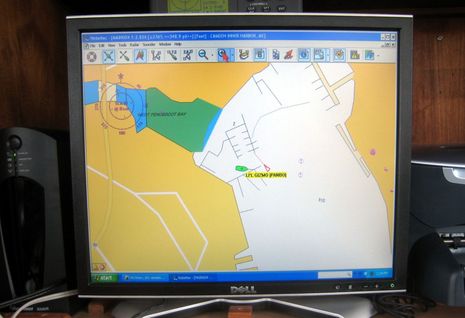
And, finally, for those readers who might be cruising Maine for the first time, below is a shot of SoZ passing Owl’s Head in June, 2008, with the Camden Hills in the background. If you wait a week or two, it may clear off like this again. I’m looking forward to seeing Capt. Kessler and NN3D at work aboard SoZ latter this summer. Rain or shine, good times ahead.


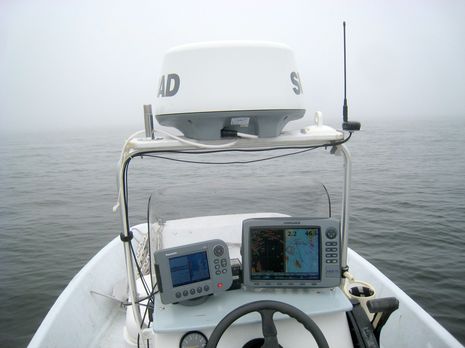
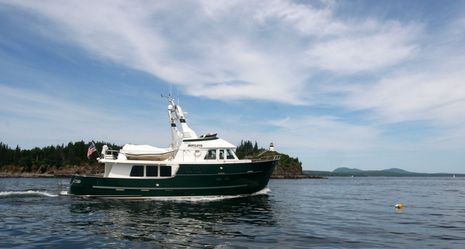
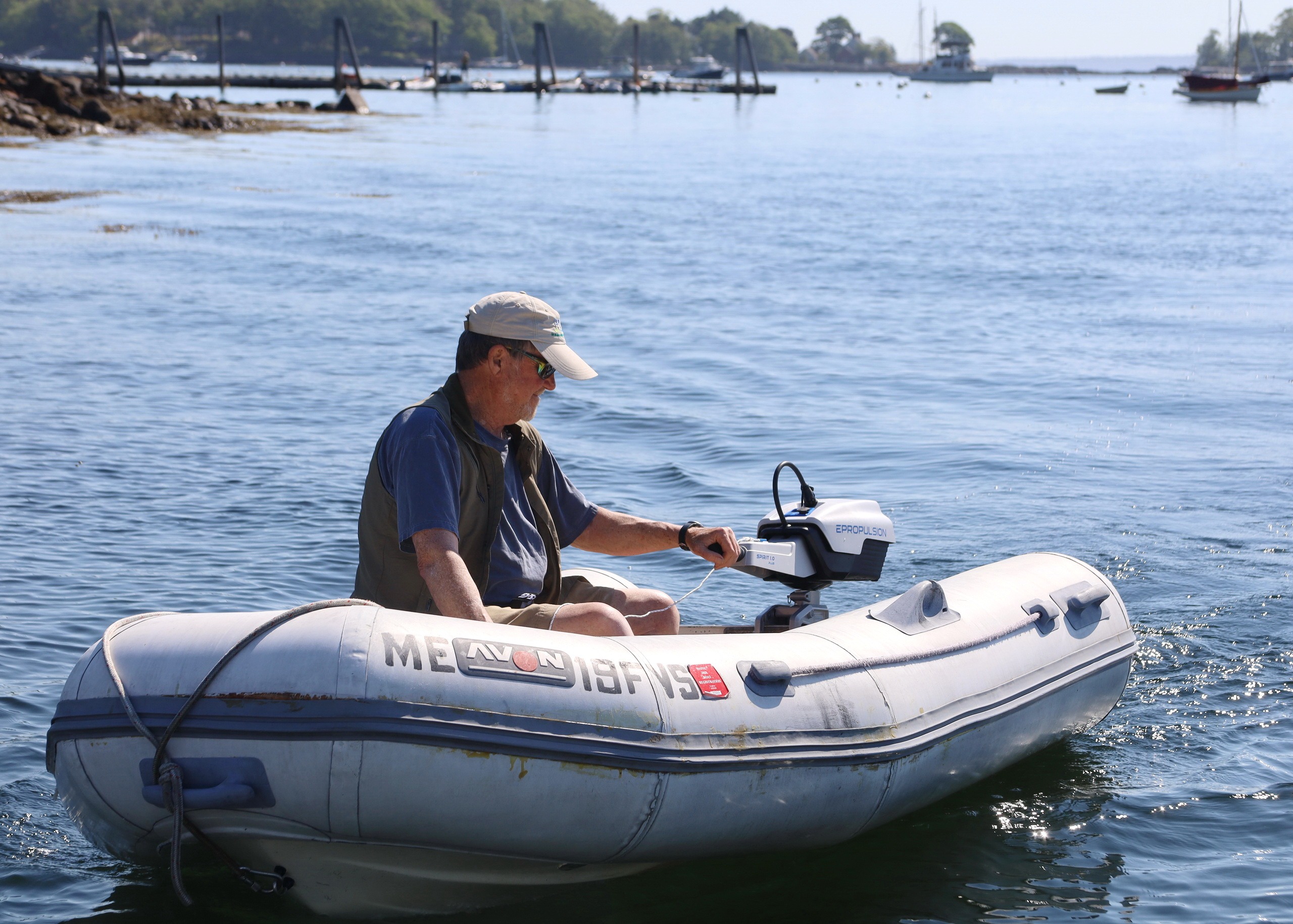










Ben-
Don’t forget that when you compare a 24″ BR radome to an 18″ “Digital” dome you are giving the BR a bit of an advantage in antenna size that provides somewhat better “Cross range” resolution. All things being equal the BR with 24″antenna will have a beamwidth that is 25% smaller or “sharper” than the 18″ Raymarine unit. Now that comparison only applies in the CROSS range dimension or AZ only – range resolution improvement of the BR24 is a valid thing to directy compare with any other radar.
I’m looking forward to seeing your data. I’ve been playing with my Raymarine 24″, 4KW dome at short ranges too – I don’t have it optimized yet but I am pleased so far. I recently had to thread the needle crossing Rosario Strait from the San Juan Islands to Anacortes – about 5 miles that was fogged in for the first 1/3 of the run. I worked the MARPA and other capabilities even after we cleared the fog for more experience.
Would love to compare my 24 with the BR 24. I know the BR will have it hands down in range resolution.
Thanks Dave, but you stumbled on some confusing nomenclature. The Navico BR24 is an 18″ scanner, with the 5.2° beam width typical of the size. The “24” in BR24 refers to its purported maximum range. Navico is going to confuse a lot of people with that one.
So comparing the BR24 to other 18″ domes is valid, I think, particularly for size constrained sailors. But I’m wondering if it should also be compared to 24″ domes that might be closer to it in terms of cost.
I’m running a BR24 with a HDS10 right now. I just fired it up to bench test it with the BR24 on the roof at the same level as a Furuno DRS4D on a Navnet 3D MFD12.
So far, either my BR24 is giving a very spoky picture and there are virtually no targets past 6 miles while the DRS4D image on the Navnet 3D Display is filled with targets. The weather is perfect.
Also, the BR24 is very slow to respond to clutter adjustments and the picture is rendered in segments which drives me nuts.
Does anyone else have comments on what could be wrong? Maybe mine is broken or the software needs to be updated.
Tech
There seems to be a lot of information on the close in range performance of the BR24, it would be nice though to start seeing some long range performance feedback too. How’s it performing at ranges of say 12 miles when compared to another 18″ dome? I have the Northstar M84 installed on my boat with a Northstar 2kw dome, it’s awesome at picking up squalls with the different colors representing intensity of returns. And when sailing off the coast of Panama and Colombia where there’s a lot of small and big ship traffic we usually use the radar on the 8 or 12 mile range for detecting traffic. It would be nice to know how the BR24 would compare with similar useage.
OK, I don’t believe it is broken. I figured out that the Furuno DRS4D was making the spokes on the BR24 Radar Image. When I put the DRS Radar to STBY, they go away.(Domes are mounted 40 feet appart) When I turn the Interference Rejection on the BR24 to HIGH, the spokes go away as well but, the BR24 loses some targets as well which is typical of Interference Rejection settings.
Short range performance appears to be good but, the long range is just not there!! I would call it is a five mile radar at best because I can barely detect mountains at six miles in perfect weather. After looking at radars for twenty years, I would not go to sea with it.
My co-worker told me that the HDS10 display has new software that might help. I’ll let him try it and advise if it improves the performance significantly.
Radar Tech
So it seems like the broadband and “HD” (both terms are marketing and meaningless) are really meant to improve close-in, what about for Ocean going \ Blue water cruisers? Should we just focus more on power consumption? Do these enhancements in shortsightedness diminish what they can do at greater distances?
I definitely want to try the BR24 and other domes at greater ranges, and will shortly be well set up to do that. But it’s gotten so that boaters use radars in very different ways. I know plenty who hardly ever use a range over six miles, and some who rarely go over three.
I have the Furuno DRS4D radar together with the MFD12, and it’s fantastic !
I have been waiting for this moment when the BR was tested against the DRS4D, and so far it seems that I was doing the right thing…
I’ve run into a couple of people with far more radar comparison experience than me who consider Furuno UHD the top performer. But there really is no overall comparison possible between a BR24 and a DRS4D, because they are so different in terms of size, power requirement, and cost. If a BR24 can duplicate or exceed a DRS4D at very near ranges, that’s really noteworthy, but not a reason to get one instead of the other. An interesting one-to-one comparison would be the BR24 and the Furuno 18″ UHD dome. Hopefully, Furuno will let me try that.
I will be using my BR24 next week on a new boat that I am taking delivery of. I will be sure to see how it performs at long ranges. From what I have seen and heard so far it can’t be beat at close ranges.
I am following these comparisons eagerly as we are going to start a circ in 2011-12 and I figure a new RADAR is about the last thing we’ll buy…next to provisions and current flares!
Interesting comments about long range performance and somewhat concerning. It sounds as though this radar will really find a home on small, maneuverable boats that operate in fairly congested areas and don’t need long range performance and as a second (or third) radar on bluewater boats. However, if they are targeting the latter group I think a black box version is in order. As with all new technology, I’m sure this will improve over time, and it definitely shows some promise.
My co-worker downloaded the newer HDS10 display software which helped the sector update speed which is now faster but still very jumpy and slow to react to adjustments.
The very, very short range performance of the BR24 is indeed better. However, I question how useful it is on the water. For example, while I agree that most customers may never use their radar at ranges over 3 or 6 miles, the advantage of using a radar for navigation at ranges less than 1/8th of a NM equally diminish! The BR24 allows a minimum range of 1/32 NM in radius (190 feet) but only about 120 feet ahead. For a boat traveling at 5 knots, this gives the operator about 10 seconds to detect a fixed target at the edge of the display ahead of own ship and only five seconds for another boat traveling at five knots toward him. 1/8th NM radius is the minimum range that I feel comfortable using for general harbor/close range navigation.
Anyway, my major complaint is with the longer range detection of the BR24. As said, I can barely detect a 3000 foot mountain at 6 miles in perfect weather. The radar reflective surface area of this mountain is at least a 100 times more than a typical boat target at the same range. While I agree that most customers don’t use their radars at ranges above 6 miles for navigation, the more important question is what can the radar detect at the six mile range? The DRS4D has about five times the range detection in the same environment.
The Auto Gain mode doesn’t work well but, this may not be an issue on the water.
It will be interesting to see other testimony besides my own admittedly “Old School” observations.
Radar Tech
I’ve just posted some images (screenshots) made with a BR24 as well as up close ones on my blog. I did manage to get echoes up to 15 nm away, although of man made objects such as villages and large boat yards.
Echos of small ships in the range 2-6 nm are clearly weaker than with traditional radars. Large ships seemed to present no problems, as did anything in close range (2 m down). In fact, up close the detail was phenomenal.
Beyond what was reported above, I clearly get the impression that, compared to traditional radars, broadband has a preference for metal, brick and other man made objects. A metallic boat shows up as its outline, not a blob. A pile shows up 10 m away. A walkway shows up, and you can still see objects beyond it. Range resolution is clearly there.
Still, the medium range target recognition of smaller ships is a definite weak point IMO.
Regards,
Kees